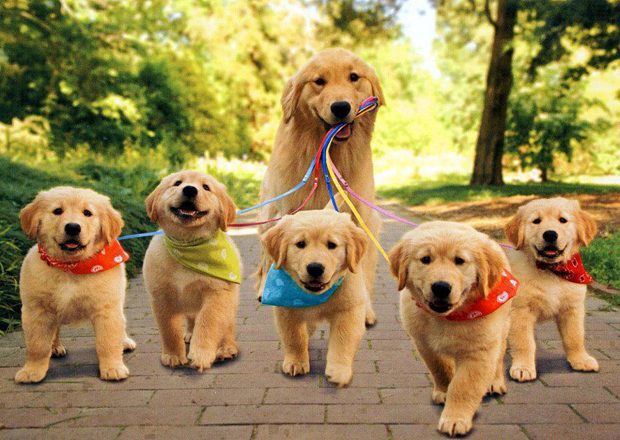Cute Dogs










Dog -
The domestic dog is a canid that is known as man's best friend. The dog was the first domesticated animal and has been widely kept as a working, hunting, and pet companion. In 2001, there were estimated to be 400 million dogs in the world.Scientific name: Canis lupus familiaris
Gestation period: 63 d on average
Daily sleep: 10.1 h on average
Height: 67 – 70 cm (At Shoulder)
Rank: Subspecies
Lifespan: 10 – 13 y, 11.08 y on average (UK population), 12.67 y on average (dying of natural causes, UK population)
"The most widespread form of interspecies bonding occurs between humans and dogs"[26] and the keeping of dogs as companions, particularly by elites, has a long history.[32] (As a possible example, at the Natufian culture site of Ain Mallaha in Israel, dated to 12,000 BC, the remains of an elderly human and a four-to-five-month-old puppy were found buried together).[16] However, pet dog populations grew significantly after World War II as suburbanization increased.[32] In the 1950s and 1960s, dogs were kept outside more often than they tend to be today[33] (using the expression "in the doghouse" to describe exclusion from the group signifies the distance between the doghouse and the home) and were still primarily functional, acting as a guard, children's playmate, or walking companion. From the 1980s, there have been changes in the role of the pet dog, such as the increased role of dogs in the emotional support of their human guardians.[34] People and dogs have become increasingly integrated and implicated in each other's lives,[35] to the point where pet dogs actively shape the way a family and home are experienced.[36] There have been two major trends in the changing status of pet dogs. The first has been the 'commodification' of the dog, shaping it to conform to human expectations of personality and behaviour.[36] The second has been the broadening of the concept of the family and the home to include dogs-as-dogs within everyday routines and practices.[36] There are a vast range of commodity forms available to transform a pet dog into an ideal companion.[37] The list of goods, services and places available is enormous: from dog perfumes, couture, furniture and housing, to dog groomers, therapists, trainers and caretakers, dog cafes, spas, parks and beaches, and dog hotels, airlines and cemeteries.[37] While dog training as an organized activity can be traced back to the 18th century, in the last decades of the 20th century it became a high profile issue as many normal dog behaviors such as barking, jumping up, digging, rolling in dung, fighting, and urine marking[further explanation needed] became increasingly incompatible with the new role of a pet dog.[38] Dog training books, classes and television programs proliferated as the process of commodifying the pet dog continued.[39] An Australian Cattle Dog in reindeer antlers sits on Santa's lap A pet dog taking part in Christmas traditions The majority of contemporary people with dogs describe their pet as part of the family,[36] although some ambivalence about the relationship is evident in the popular reconceptualization of the dog–human family as a pack.[36] A dominance model of dog–human relationships has been promoted by some dog trainers, such as on the television program Dog Whisperer. However it has been disputed that "trying to achieve status" is characteristic of dog–human interactions.[40] Pet dogs play an active role in family life; for example, a study of conversations in dog–human families showed how family members use the dog as a resource, talking to the dog, or talking through the dog, to mediate their interactions with each other.[41] Another study of dogs' roles in families showed many dogs have set tasks or routines undertaken as family members, the most common of which was helping with the washing-up by licking the plates in the dishwasher, and bringing in the newspaper from the lawn.[36] Increasingly, human family members are engaging in activities centered on the perceived needs and interests of the dog, or in which the dog is an integral partner, such as Dog Dancing and Doga.[37] According to statistics published by the American Pet Products Manufacturers Association in the National Pet Owner Survey in 2009–2010, it is estimated there are 77.5 million people with pet dogs in the United States.[42] The same survey shows nearly 40% of American households own at least one dog, of which 67% own just one dog, 25% two dogs and nearly 9% more than two dogs. There does not seem to be any gender preference among dogs as pets, as the statistical data reveal an equal number of female and male dog pets. Yet, although several programs are undergoing to promote pet adoption, less than a fifth of the owned dogs come from a shelter. The latest study using Magnetic resonance imaging (MRI) to humans and dogs together proved that dogs have same response to voices and use the same parts of the brain as humans to do so. This gives dogs the ability to recognize emotional human sounds, making them friendly social pets to humans









